Steam Page || Developer’s Site
The warp mechanic in Zangeki Warp revolutionizes horizontal shmups to a degree on par with what Ikaruga‘s color shifting did for vertical bullet hells. On the surface this game looks much like other horizontal shmups and the R-Type influences in particular ring loud and clear, yet the ability to warp your ship around changes everything. The warp isn’t just there to save you from close calls, the entire game is build around it.
Aside from warping away to dodge bullets, you’ll constantly be asked to use it to circumvent solid obstacles and to obliterate enemies via the warp trail which your ship’s gun can’t reach. By the end of the game I felt like I was relying on this technique more than my bullets in combat and the final stages become very demanding indeed, even on Normal! Beyond the main feature itself, Zangeki Warp earns plenty of praise with significantly varied difficulty settings, a rather nice upgrade system, and exceptional enemy designs which gradually shift from standard robots and ships to creepy body horror-style monsters which would even make Abadox proud.
Your warp is your lifeline. It is simultaneously your most valuable tool for survival and your greatest weapon for ripping enemies to shreds. So, just how does it work? Holding down the warp button will put you in a state I’ll refer to as Warp Mode; time freezes and you move around a circle attached to your ship via a thin line. Releasing the button immediately warps your ship to the circle’s location as time resumes and any enemies along the line between the two points will take severe damage.
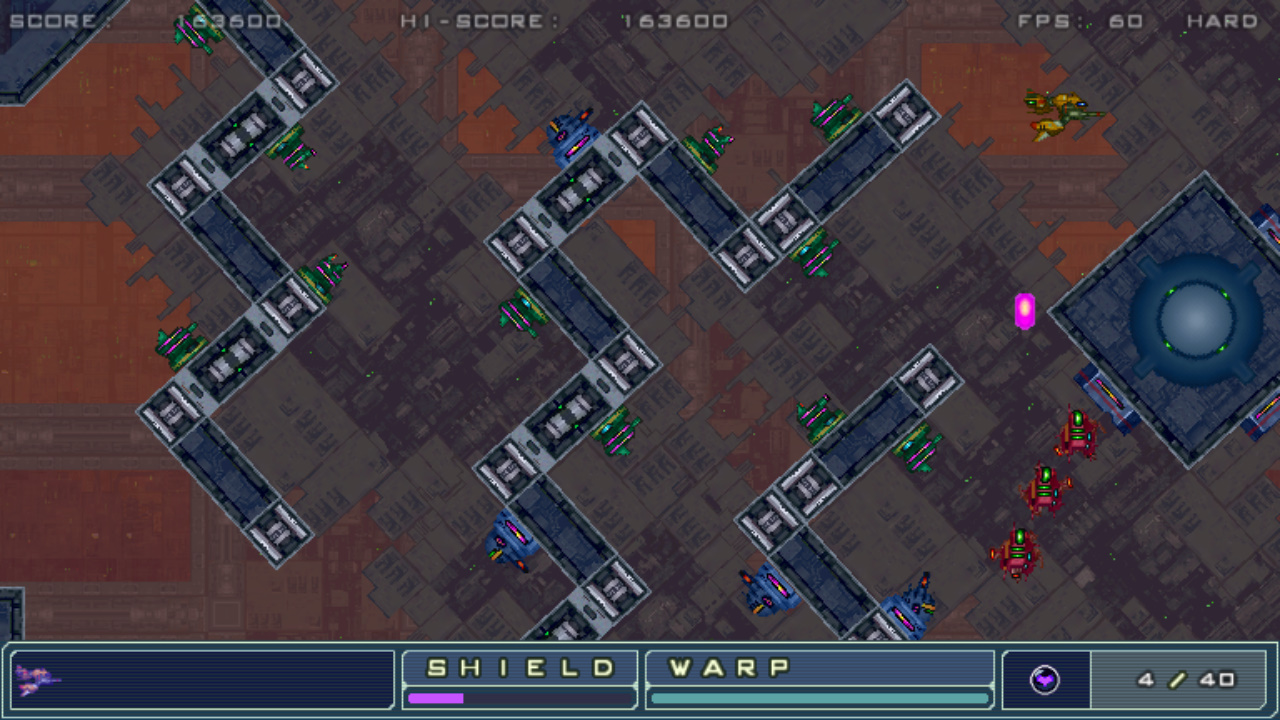
You can warp anywhere on the screen and you can chain together warps virtually instantaneously, a technique which becomes mandatory later on, though there are some catches. Your Warp Meter constantly drains while you’re in this mode and, while the circle can pass through walls, it’s a bit on the slow side. Take too long to position the circle while warping or try to chain together too many warps and you could very well run out of energy and end up warping yourself straight into a wall or on top of an enemy. Thankfully, your energy refills so quickly that you only need to pay attention to the bar during particularly intense moments. Shooting reduces the refill speed, but it’s such a minor penalty that I didn’t notice it at any point except when I tried playing on the ‘Insane’ difficulty.
The stages in Zangeki Warp would be impossible in just about any other shmup. Hugging the left side of the screen is rarely a good idea as enemies like to appear behind you, especially in narrow corridors. Furthermore, while I called this a ‘horizontal shmup’, there are segments which scroll vertically up or down as well. Even though enemies are capable of attacking from all sides and the screen can scroll in multiple directions, your own ship can only ever shoot to the right. This leaves your warp slash as your sole option for fighting back against threats behind you or tucked away inside small crevices.
Your gun and warp slash are the only weapons available to you, so it’s a good thing that you can upgrade them! Zangeki Warp opts for permanent upgrades over temporary ones and you get three upgrade points to play around with at the start of every stage. What’s more, if you run out of lives and continue from a checkpoint you can redistribute the current stage’s points to try a new strategy. Shot power, warp recovery, and slash power are the bread and butter skills and they do what their names imply, though shot power is less about boosting your primary gun and more about adding rows of diagonal, front-facing guns to your sides for some vertical range.
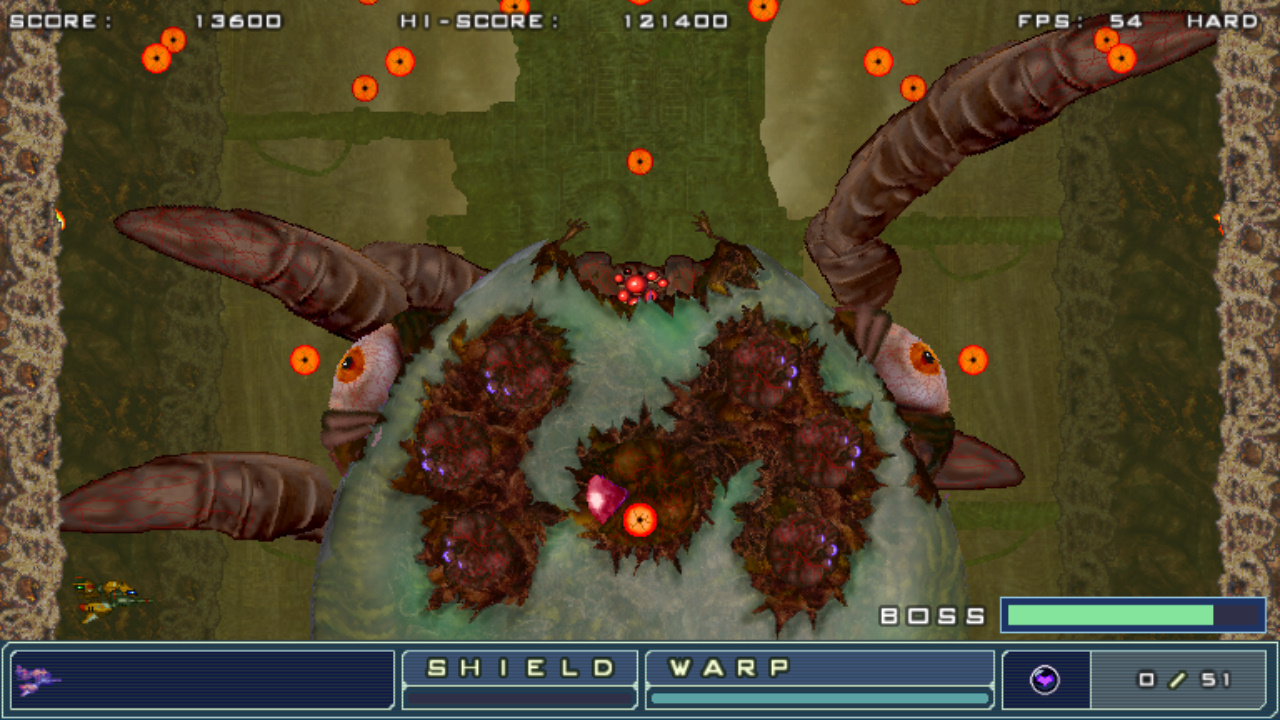
Shockwave requires two points in warp recovery to unlock, but it’s worth the investment as it causes your ship to create a shockwave at any points it warps to so you can hit any nearby enemies outside of the slash’s range. The bottom three skills are more complicated and, unlike the top three, you don’t start with a point in them by default. Decoy stay creates a temporary clone at any point you warp from to attract bullets. Decoys carry some risk if you like to warp back and forth frequently as you can end up warping away from safety straight into a cloud of bullets, though they are extremely valuable tools once you get used to them.
As for shield recovery, you normally collect hearts from containers in stages to fill up a shield bar which, when full, gives your ship a shield that absorbs a single hit. However, with the shield recovery skill your bar gradually fills over time and if you really invest in it the bar can fill remarkably quickly. last of all is overdrive, the closest thing to a bomb in Zangeki Warp as it creates a temporary blast around you whenever your shield breaks; overdrive requires an investment in shield recovery so I never used it much.
What I like about this skill system is just how flexible it is. The skills are largely passive in nature and none of them feel completely mandatory the way speed boosts do in Gradius They also allow you to adapt your ship to your preferred playstyle without changing the core gameplay. Invest in shield recovery and decoys if you enjoy playing defensively and some points in overdrive will even give you an offensive edge.
On the other hand, if you like having range then shot power can be upgraded more than any other skill and at the max level you have a ridiculous number of guns to hit just about any enemy remotely in front of you and to rapidly drain away the health of bigger targets. Of course, if you’re like me and prefer warping around then the combination of warp recovery, slash power, and shockwave will allow you to zigzag a path of destruction across the screen. With seven stages, Zangeki Warp grants players a grand total of 21 points to play around with, which is more than enough to invest heavily in your favorite skills while having a few left over to round things out.
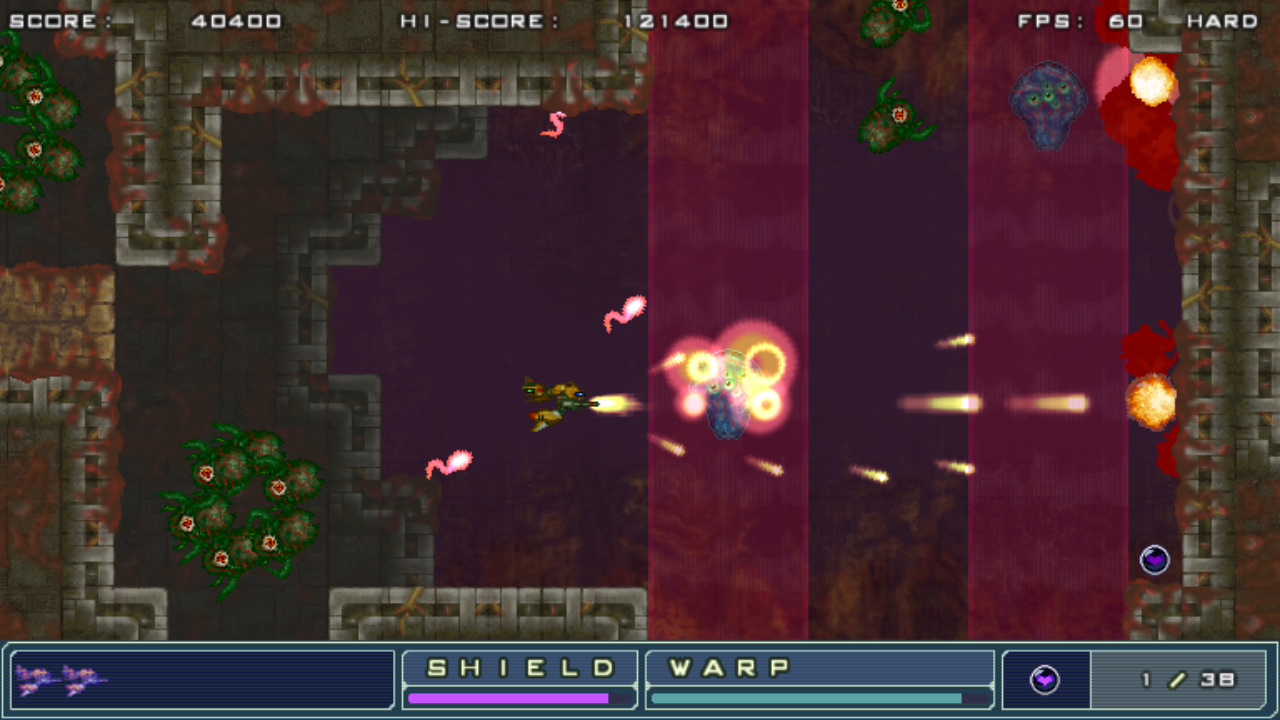
Even the best of mechanics wouldn’t save a game with poor stage design and Zangeki Warp‘s stages definitely deliver across the board. Variety is king here as every stage finds new ways to play with the warp mechanic. The first stage serves as something of a tutorial with metal orbs you need to slice through with warps, a falling ceiling, and a split path segment where you can freely warp to whichever path feels safer at any given time. The second stage immediately steps things up with some vertical scrolling and all sorts of deadly traps which can destroy your ship and enemies alike. Every stage has at least one memorable gimmick like rotating rooms, regenerating walls of flesh, and, my personal favorite, an upside-down river filled with fish where you must use your warp to overcome the current.
Beyond gimmicks, just about every stage is visually distinctive as well. The first stage’s aesthetic is somewhat deceptive in nature. It’s clean, sleek, and filled with futuristic technology; a screenshot of Stage 1 would look virtually identical to that of a hundred other shmups. A dramatic shift happens the moment you reach Stage 2. Everything is still quite metallic, but the sleekness is replaced by a visceral edge. Giant metal blades stab out of the walls, their edges covered in blood, massive hammers swing in merciless arcs, and guillotines ceaselessly chop down upon cleaved alien corpses to make for a creative contrast between a futuristic setting and ancient weaponry. Stage 4 is where Zangeki Warp completely flips, shoving anything metallic into the background to make way for a biological hellscape as you fight giant insects and nightmarish globs of flesh and eyes. The only stage which doesn’t stand out visually is Stage 3, which is rather similar in appearance to Stage 1, though even this stage remains memorable with all sorts of rotating hazards.
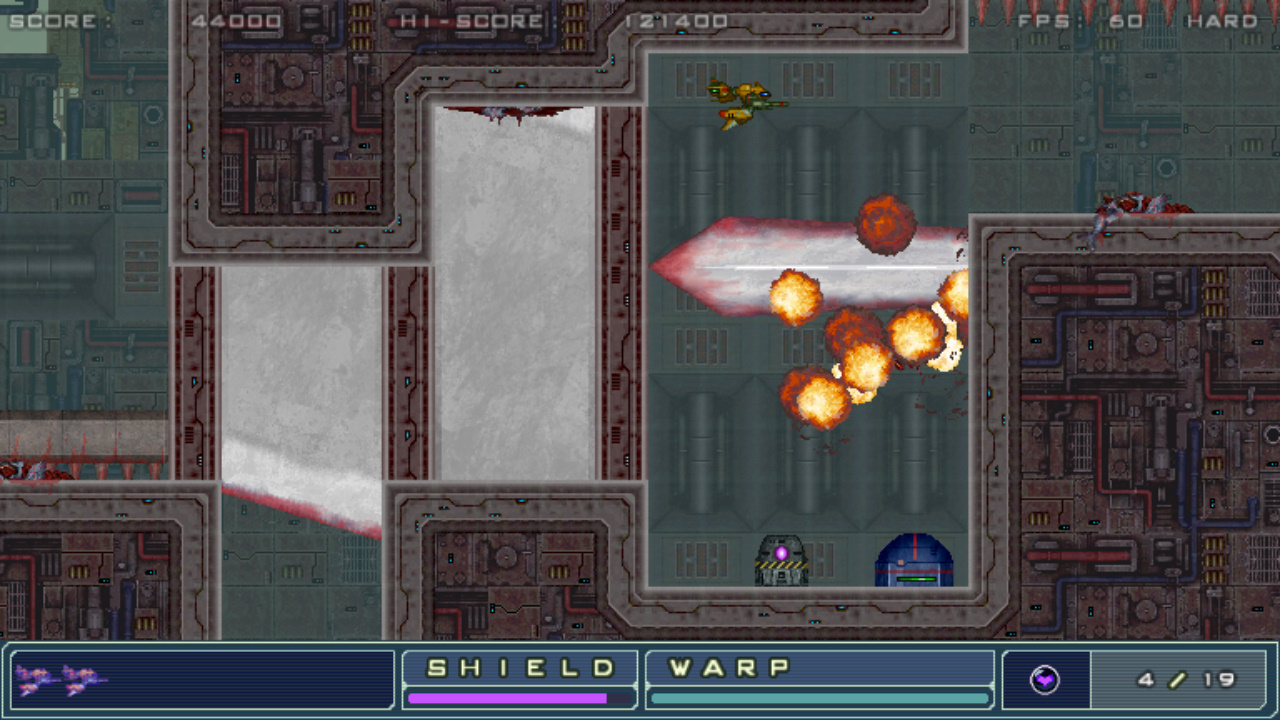
Zangeki Warp is an incredibly difficult game, but also a surprisingly generous one. I died plenty of times even on Normal and I was just barely able to finish Hard after dozens of deaths while even the first stage is a true challenge on Insane. Bullets move fast and you’ll probably need to rely at least somewhat on memorization for the final few segments unless you’re exceptionally good at warping (or have a defensive build).
Difficulty also increases in a big way between settings with bosses gaining new attacks and much more health at higher levels, entirely new groups of enemies, and more subtle tweaks to patterns and attack speeds. However, you also have infinite continues and every stage seems to have at least three checkpoints so you never lose much progress. You can even make saves if you can’t beat the whole game in one sitting, though loading will send you back to the start of the stage with your upgrades intact.
The only real downsides to Zangeki Warp are minor ones. Bosses (and midbosses) on Normal can potentially be threatening, but in most cases all it takes is a few quick warp slashes near the start of the fight and a few bullets to kill them before they get to do much of anything. Hard and Insane both seem to give bosses a health boost so this issue is reduced, though not completely gone, on higher difficulties.
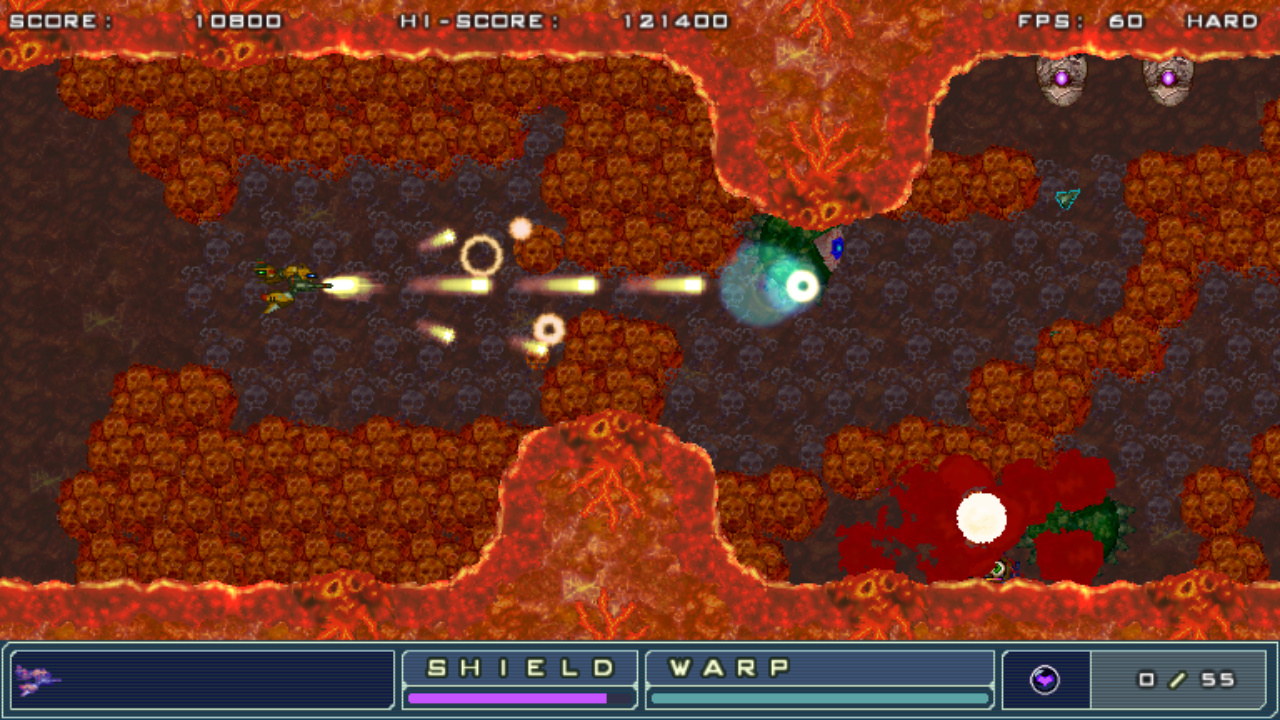
The scoring system is also on the barebones side with no graze or combo systems. Aside from enemies killed within the stages, most of your points are from bonuses at the end of each stage for killing bosses below a par time, not dying, and collecting shield meter items. As a result, your rank for each stage is generally either very high or very low depending on your death count, especially since even a single death will reset your shield item count.
Zangeki Warp is truly a fantastic shmup. Influences from past shmups can be felt all over the place, but it ultimately relies upon smart stage design carefully centered around its own namesake mechanic. Zangeki Warp is not only one of the best horizontal shmups I’ve played, it’s a testament to how much room for growth and innovation still exists within its genre.